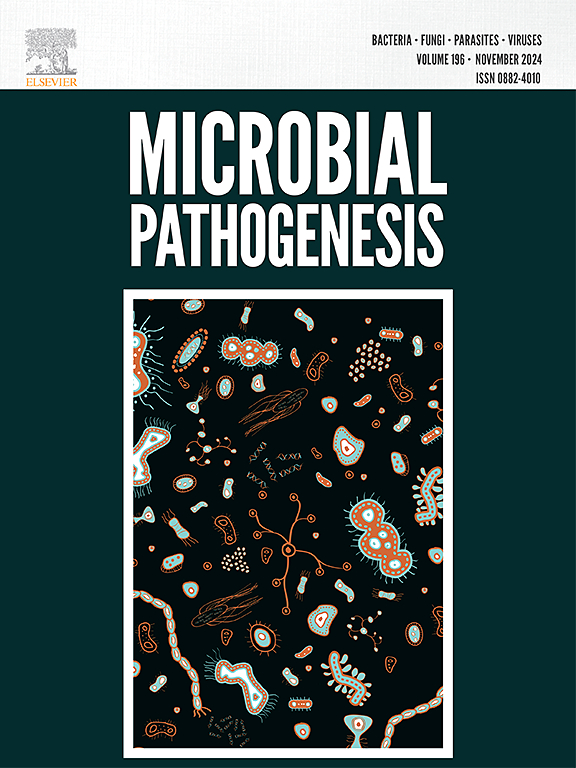多杀性巴氏杆菌四重实时荧光定量PCR检测方法鉴定及血清分型
IF 3.5
3区 医学
Q3 IMMUNOLOGY
引用次数: 0
摘要
多杀性巴氏杆菌是一种人畜共患病原体,具有感染多种宿主的能力,包括通过与宠物接触感染人类。由于其不同的荚膜血清群,快速准确的鉴定以及血清分型对于有效预防和控制由该细菌引起的感染至关重要。本研究建立了一种四重定量PCR (qPCR)方法对多杀性假单胞菌进行鉴定和血清分型,专门区分猫和其他宿主的荚膜血清群a、D和F。引物和探针针对kmt1基因(物种特异性)、hyaD-hyaC基因间区(血清组A)、dcbF(血清组D)和fcbD(血清组F)。该方法对多杀假单胞菌的检出限为1.7 copies/μL,对荚膜血清群a、D和F的检出限分别为2.03、11.24和14.52 copies/μL。该试验未显示与其他病原体或不同血清群的交叉反应性。测定内、测定间变异系数均小于1%,具有良好的重现性和特异性。应用该方法对121只家猫的呼吸道拭子进行了检测,其中96只检测出多杀性假单胞菌阳性。其中荚膜血清A组66例,荚膜血清D组1例,荚膜血清f组24例,分型结果与阳性标本细菌分离结果高度一致。本研究提供了一种快速、准确、高通量的多杀假单胞菌荚膜血清群a、D和f的鉴定和分型方法,为深入研究多杀假单胞菌致病机制和实施公共卫生控制措施提供了有力的工具。本文章由计算机程序翻译,如有差异,请以英文原文为准。
A quadruplex real-time fluorescent quantitative PCR detection method for identification and serotyping of Pasteurella multocida
Pasteurella multocida is a zoonotic pathogen with the ability to infect a diverse range of hosts, including humans through contact with pets. Due to its diverse capsular serogroups, rapid and accurate identification, as well as serotyping, are essential for the effective prevention and control of infections caused by this bacterium. This study developed a quadruplex quantitative PCR (qPCR) method for the identification and serotyping of P. multocida, specifically differentiating capsular serogroups A, D, and F in cats and other hosts. Primers and probes targeted the kmt1 gene (species-specific), hyaD-hyaC intergenic region (serogroup A), dcbF (serogroup D), and fcbD (serogroup F). The developed method demonstrated a detection limit of 1.7 copies/μL for the identification of P. multocida and 2.03, 11.24, and 14.52 copies/μL for the serotyping of capsular serogroups A, D, and F, respectively. The assay did not display cross-reactivity with other pathogens or different serogroups of P. multocida. Both the intra-assay and inter-assay coefficients of variation are below 1 %, highlighting the excellent reproducibility and specificity of the method. Applying this method, we examined 121 respiratory swabs from domestic cats, and 96 were tested positive for P. multocida. Among these positive samples, 66 were determined as capsular serogroup A, 1 as capsular serogroup D, and 24 as capsular serogroup F. The typing results exhibited high concordance with those obtained through bacterial isolation from the positive samples. The method developed in this study offers a rapid, accurate, and high-throughput approach for the identification and serotyping of P. multocida capsular serogroups A, D, and F. It serves as a powerful tool for advancing research into the pathogenic mechanisms of P. multocida and for implementing public health control measures.
求助全文
通过发布文献求助,成功后即可免费获取论文全文。
去求助
来源期刊

Microbial pathogenesis
医学-免疫学
CiteScore
7.40
自引率
2.60%
发文量
472
审稿时长
56 days
期刊介绍:
Microbial Pathogenesis publishes original contributions and reviews about the molecular and cellular mechanisms of infectious diseases. It covers microbiology, host-pathogen interaction and immunology related to infectious agents, including bacteria, fungi, viruses and protozoa. It also accepts papers in the field of clinical microbiology, with the exception of case reports.
Research Areas Include:
-Pathogenesis
-Virulence factors
-Host susceptibility or resistance
-Immune mechanisms
-Identification, cloning and sequencing of relevant genes
-Genetic studies
-Viruses, prokaryotic organisms and protozoa
-Microbiota
-Systems biology related to infectious diseases
-Targets for vaccine design (pre-clinical studies)
 求助内容:
求助内容: 应助结果提醒方式:
应助结果提醒方式:


